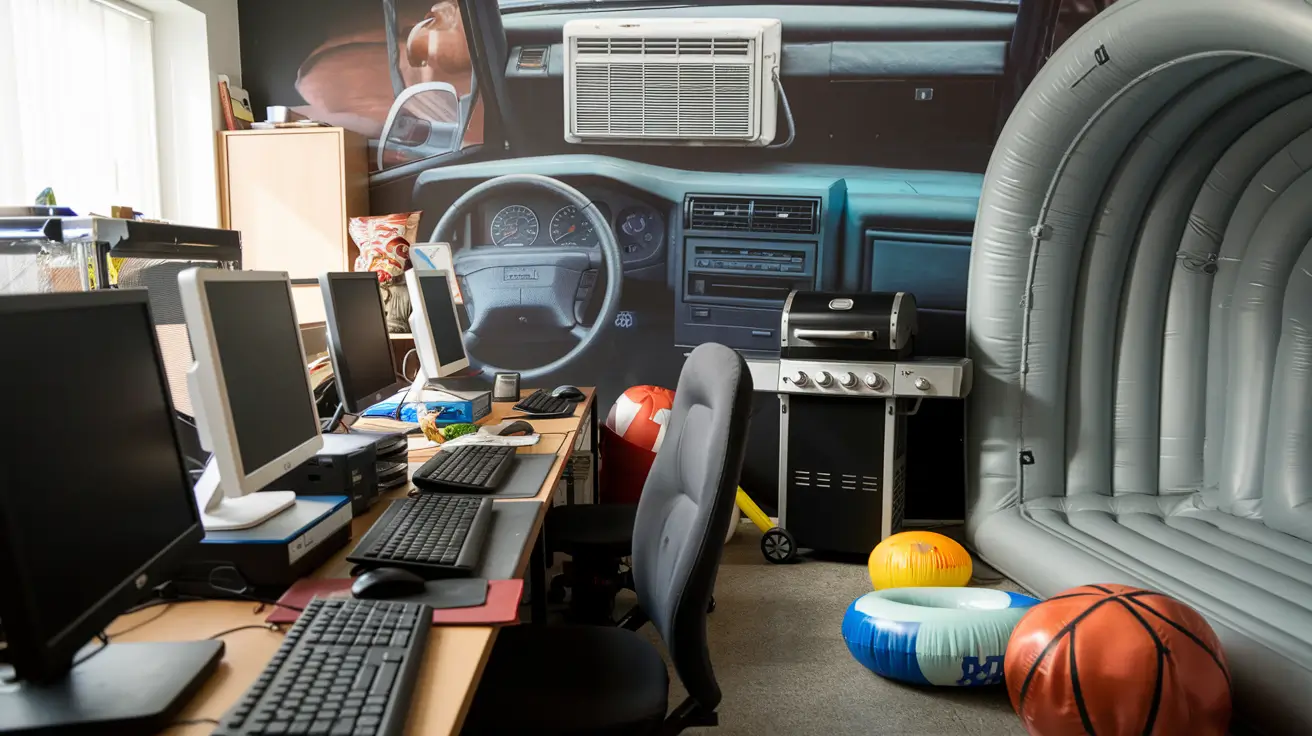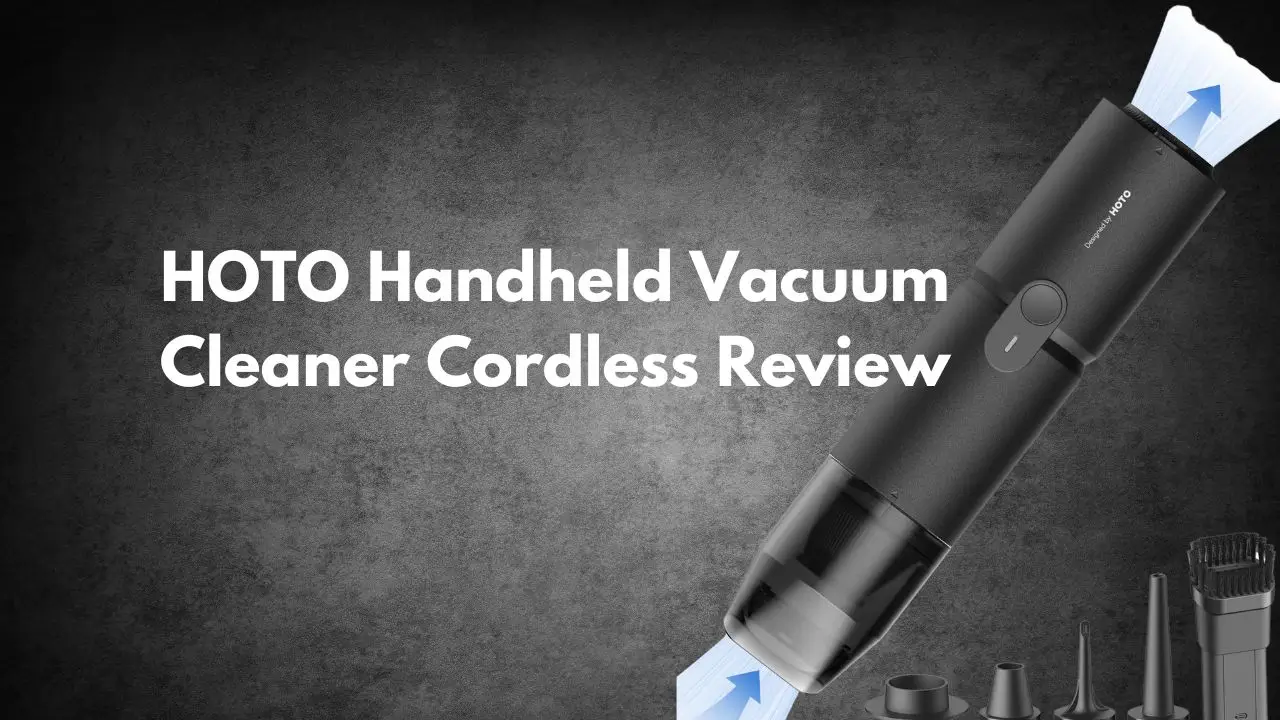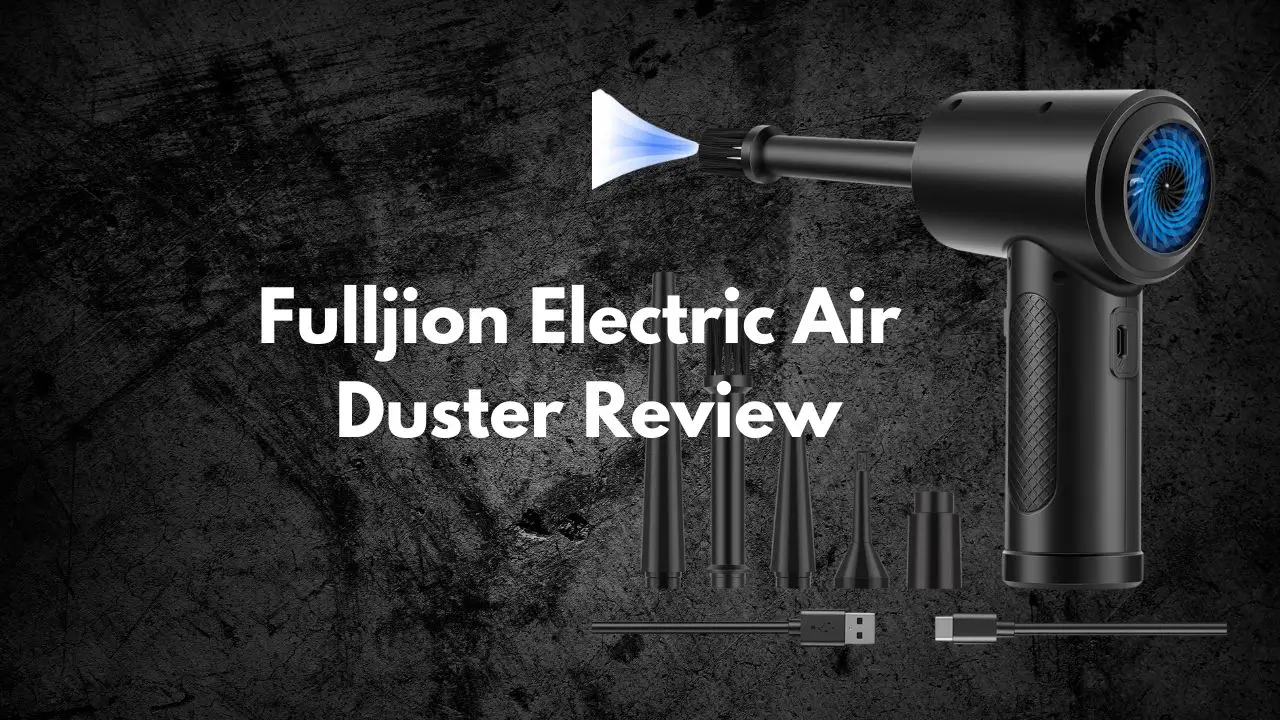Electric Air Dusters for Car Cleaning have revolutionized the way vehicle owners maintain their cars’ interiors. These portable devices provide powerful, focused air streams that remove dust from hard-to-reach areas without the environmental concerns of traditional compressed air cans.
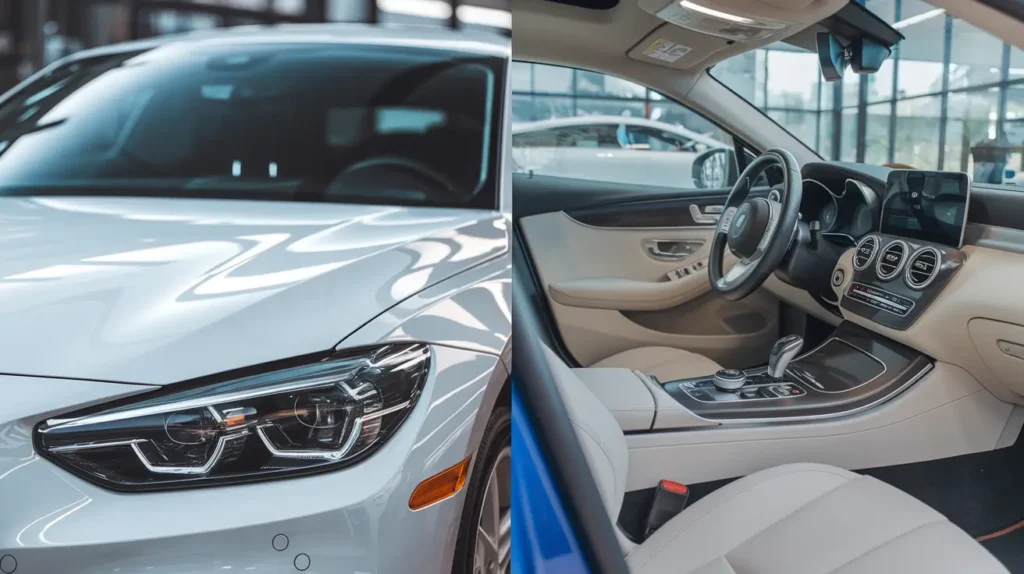
Electric air dusters deliver superior cleaning performance while being cost-effective in the long run, as they eliminate the need for disposable canned air products.
Their rechargeable batteries provide consistent power for thorough cleaning sessions, ensuring every crevice in your vehicle remains dust-free.
Kinzir, the leading manufacturer in China, designs electric air dusters with innovative features specifically tailored for automotive applications. Their products combine ergonomic design with powerful motors that effectively remove debris from air vents, dashboard components, and other intricate areas that regular cleaning tools cannot reach.
What Is An Electric Air Duster?
An Electric Air Duster is a handheld device that produces a powerful stream of air used for cleaning dust and debris from various surfaces.
Unlike traditional aerosol dusters, electric models use rechargeable batteries to power a motor that generates compressed air.
These innovative cleaning tools typically feature multiple pressure settings and specialized nozzle attachments for different cleaning applications.
Most electric dusters can produce air pressure between 30-70 PSI, making them effective for both delicate electronics and stubborn dirt removal.
The key components of an electric air duster include:
- High-efficiency motor
- Rechargeable lithium-ion battery
- Pressure regulation system
- Ergonomic handle design
- Various specialized nozzle attachments
Electric air dusters are environmentally friendly alternatives to chemical-based compressed air cans. They eliminate the use of harmful propellants and reduce waste from disposable canisters.
Modern electric dusters often include built-in LED lights to illuminate dark areas during cleaning.
Battery life typically ranges from 15-30 minutes of continuous use, depending on the pressure setting selected.
These devices are particularly valuable for automotive cleaning due to their portability and ability to reach tight spaces. Their reusable nature makes them cost-effective for regular maintenance tasks compared to disposable options.
Importance Of Regular Car Interior And Exterior Cleaning
Regular cleaning of your car’s interior and exterior is not just about aesthetics—it’s a fundamental aspect of proper vehicle maintenance.
A clean car helps preserve its value and extends its lifespan through the prevention of premature wear and deterioration.
Dust, dirt, and debris accumulate quickly on both exterior and interior surfaces. These particles can act as abrasives, scratching paint and damaging upholstery when left untreated for extended periods.
Interior Cleaning Benefits:
- Prevents allergen buildup
- Reduces unpleasant odors
- Maintains the quality of interior materials
- Creates a healthier environment for passengers
Road salt, bird droppings, and tree sap are particularly harmful to your vehicle’s exterior. These substances contain corrosive properties that can damage your paint and eventually lead to rust formation if not promptly removed.
Recommended Cleaning Schedule:
| Area | Frequency | Key Tools |
|---|---|---|
| Interior | Bi-weekly | Electric air duster, microfiber cloths |
| Exterior | Weekly | Car wash solution, wax |
| Engine Bay | Quarterly | Degreaser, electric air duster |
Professional-grade automotive cleaning products help maintain both appearance and functionality.
Modern car care products are specifically formulated to clean without damaging sensitive surfaces.
Using the right car maintenance equipment makes cleaning more efficient and effective. Electric air dusters have become essential car care products for reaching tight spaces and removing dust without scratching surfaces.
Routine cleaning also provides an opportunity to inspect your vehicle for potential issues before they become serious problems. This preventative approach can help identify loose components, leaks, or wear patterns early.
Benefits Of Using An Electric Air Duster As Both A Duster And Vacuum For Cars
Electric air dusters offer exceptional versatility for automotive detailing enthusiasts. These dual-function tools provide both powerful air blowing capabilities and vacuum functionality in a single device, streamlining the car cleaning process significantly.
The primary advantage is their ability to clean hard-to-reach areas that traditional cleaning methods cannot access.
Dashboard vents, narrow console gaps, and intricate door panel designs are easily addressed with a focused stream of air or vacuum suction.
Time-saving efficiency is another key benefit. Instead of switching between multiple car cleaning gadgets, detailers can transition from blowing dust out of crevices to vacuuming it away with a simple adjustment.
Many electric dusters are cordless, offering unrestricted movement around and inside the vehicle.
This mobility proves invaluable when cleaning complex interior spaces or external areas like wheel wells and grilles.
Professional car cleaning tools like these typically include specialized attachments designed specifically for automotive applications:
- Brush nozzles for agitating embedded dirt
- Extended precision tips for narrow spaces
- Soft bristle attachments for delicate surfaces
- Variable pressure settings for different cleaning needs
Energy efficiency represents another advantage over compressed air cans. Electric dusters provide continuous operation without diminishing power, eliminating the recurring expense of disposable air canisters.
The environmental benefits cannot be overlooked.
By choosing reusable electric dusters, car owners reduce waste from disposable cleaning products.
Many modern units also incorporate HEPA filtration, capturing fine particulates rather than simply redistributing them.
Part 1: Interior Uses Of Electric Air Dusters
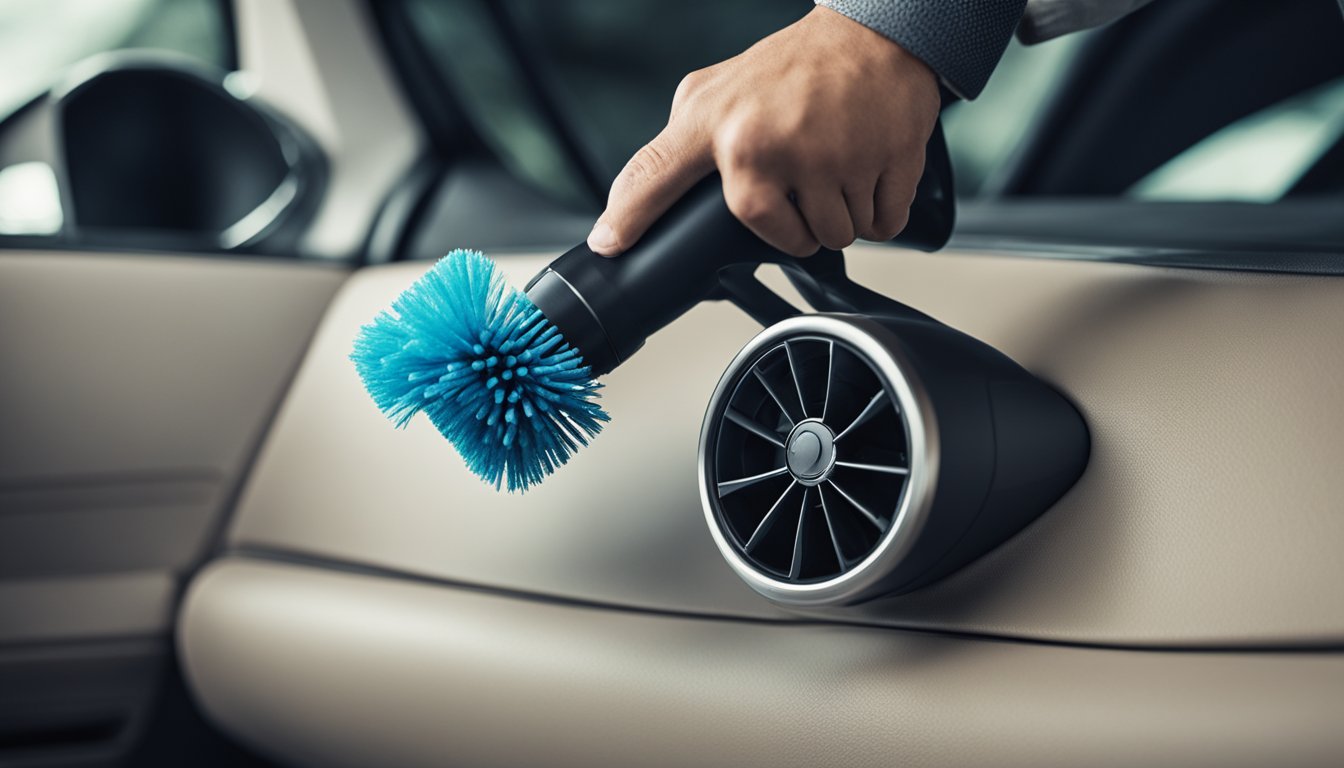
Electric air dusters have revolutionized interior car cleaning with their powerful, precise airflow that reaches places traditional dusting tools cannot.
These cordless devices make quick work of dust and debris while being environmentally friendly alternatives to compressed air cans.
Dashboard And Instrument Panel
The dashboard and instrument panel collect dust rapidly due to their horizontal surfaces and constant exposure.
Electric air dusters excel at cleaning these areas without scratching delicate surfaces or disturbing sensitive electronics.
Start by using the lowest setting to prevent scattering dust throughout the cabin.
Direct the nozzle at a slight angle rather than perpendicular to surfaces for better dust removal.
For instrument clusters with digital displays, the focused airstream removes dust without introducing moisture that could damage electronics.
Pay special attention to steering column controls, gauge surrounds, and display screens. These areas have small crevices where dirt accumulates.
The precision tips included with most electric dusters help target these narrow spaces effectively.
For vehicles with textured dashboards, use a sweeping motion to dislodge particles trapped in the texture. Follow dusting with a microfiber cloth to capture any remaining particles that were loosened but not blown away.
HVAC Vents
Air vents harbor significant dust that can affect air quality and system performance. Electric dusters provide the perfect solution for thorough cleaning without disassembly.
Turn off your climate control system before cleaning vents.
Insert the narrowest attachment into vent openings and use short bursts rather than continuous airflow. This prevents dust from being pushed deeper into the system.
Work methodically from top vents to bottom, as gravity will cause some dust to fall.
For adjustable vents, position them in different angles to access all internal surfaces. Many electric dusters come with extension tubes ideal for reaching deeper into vent systems.
For heavily soiled vents, hold a vacuum near the opposite side of where you’re blowing to capture dust rather than redistributing it. This two-tool approach maximizes efficiency.
Remember that regular vent cleaning improves HVAC performance and helps reduce cabin odors by removing mold-supporting dust deposits.
Center Console & Cup Holders
Center consoles and cup holders collect everything from coffee spills to food crumbs, making them challenging to clean thoroughly without specialized tools.
Start with cup holders, where the concentrated airflow from an electric duster can blast out debris from the bottom corners.
For dried liquids, a brief dusting loosens particles that can then be wiped away.
The narrow space between console and seats benefits from the extended nozzle attachments.
Direct air into these gaps to force out coins, receipts, and other items that may have fallen there.
Button clusters on the console often collect grime in the surrounding crevices. Use precise nozzle attachments at moderate power to clear these spaces without risking damage to electronic components.
For vehicles with removable liners in cup holders, take them out first for separate cleaning, then use the duster to clean the housing underneath.
Door Panels And Handles
Door panels feature numerous small crevices around handles, window controls, and speaker grilles that trap dust and debris.
Begin with door pockets, using strong airflow to dislodge heavier items like gravel or coins.
The contoured design of most door panels creates natural dust traps that benefit from the precision of an electric duster.
Window control panels often have small gaps around buttons that collect grime. Use a medium pressure setting with a narrow nozzle to clear these areas effectively.
Door handles and lock mechanisms accumulate both dust and skin oils. Directed airflow helps remove loose particles before wiping with appropriate cleaners.
Speaker grilles particularly benefit from air dusting, as traditional methods might push dust through the perforations and into the speaker components. Gentle, consistent airflow removes dust without this risk.
Seats And Seat Rails
Vehicle seats harbor significant dust, hair, and debris in their fabric, seams, and mechanical components. Electric dusters effectively clean these areas without the abrasion of brushes.
For fabric seats, use medium pressure to blast dust and allergens from the surface and seams.
Work in small sections, moving from top to bottom. The concentrated airflow can reach deep into fabric fibers where vacuum cleaners might only address surface dust.
Seat rails and adjustment mechanisms collect significant debris that can affect proper functioning. Use the highest pressure setting with an extension nozzle to clear these mechanical components.
For leather seats, use lower pressure settings to avoid surface damage while still removing dust from stitching and seams.
Pay special attention to perforated leather, where dust collects inside the tiny holes.
Headrests and seat belt mechanisms also benefit from thorough dusting, especially in the connection points where manual cleaning is difficult.
Carpets And Floor Mats
Vehicle carpeting traps substantial debris that vacuums might miss. Electric dusters provide additional cleaning power, especially for embedded particles.
Remove floor mats first and use the air duster to blow debris from deep within carpet fibers.
This preliminary step makes subsequent vacuuming more effective by loosening trapped dirt.
For floor mats with rubber or carpet surfaces, direct air along the edges and corners where dirt accumulates.
Hold mats vertically and blow from top to bottom to utilize gravity.
The areas under pedals collect significant dirt but are difficult to reach. Electric dusters with angled nozzles can access these spots without requiring uncomfortable contortions.
For stubborn debris in carpeting, use a stiff brush first to loosen particles, then follow with the electric duster for maximum removal.
This combination works particularly well for salt residue and dried mud.
Headliners And Sun Visors
Headliners present unique cleaning challenges due to their delicate nature and overhead position. Electric dusters provide safe, effective cleaning solutions.
Use the lowest effective setting when addressing headliners to prevent damage to the adhesive that holds the fabric in place.
Wide, sweeping motions work best rather than concentrated blasts in one area.
Sun visors collect significant dust on their upper surfaces. Direct air along these rarely-cleaned areas while supporting the visor to prevent excess movement during cleaning.
Attention to details like dome lights, sunroof controls, and microphone grilles in the headliner area ensures complete interior maintenance. The precision tips of electric dusters can target these small components effectively.
For vehicles with panoramic sunroofs, use the duster to clean the tracks and seals where debris often accumulates and can cause performance issues.
Glove Compartment & Storage Areas
Storage compartments often become repositories for dust and small debris. Electric dusters excel at cleaning these enclosed spaces.
Empty the glove compartment completely before cleaning.
Use the duster to reach rear corners and hinges where dust accumulates. The concentrated airflow can dislodge trapped debris without making a mess.
Part 2: Exterior Uses Of Electric Air Dusters
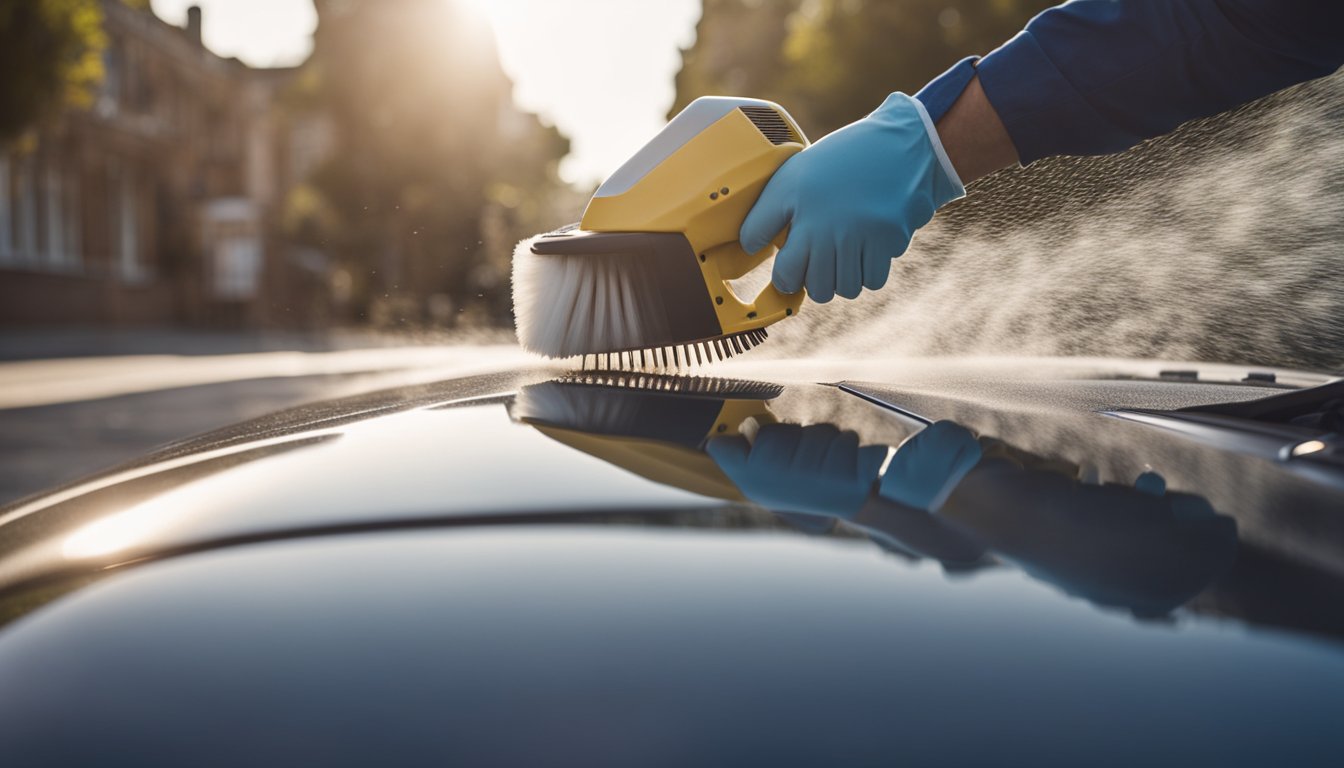
Electric air dusters offer remarkable versatility for exterior car cleaning, providing precision and power without the risk of water damage. These tools reach tight spaces and remove debris that traditional cleaning methods might miss.
Engine Bay And Components
The engine bay accumulates significant dust, leaves, and road debris that can affect performance if left unchecked. Electric air dusters provide a safe alternative to water-based cleaning, eliminating the risk of electrical component damage.
Begin by ensuring the engine is cool before cleaning.
Remove any large debris by hand first, then use the air duster with its focused nozzle to blast away dust from hard-to-reach areas around the engine block.
Pay special attention to cooling fins on the radiator where airflow is critical. Dust buildup here can lead to overheating issues.
For particularly dirty engines, work systematically from top to bottom. This prevents dislodged dirt from contaminating already cleaned areas.
Important components to focus on:
- Air intake system
- Battery terminals and surrounding area
- Fuse box exterior
- Engine cover and surrounding seams
Grilles And Air Intakes
Front grilles and air intakes trap significant amounts of debris, reducing airflow and diminishing cooling efficiency. Regular cleaning with an electric air duster preserves both functionality and appearance.
Start with the external grille, working from the center outward. The concentrated air stream effectively dislodges bugs, pollen, and road film that accumulate during driving.
For cooling intakes, use the precision nozzle attachment to reach between narrow slats. This prevents buildup that could otherwise restrict airflow to the radiator.
Make sure to clean these areas more frequently if you drive in dusty or rural areas.
| Driving Environment | Cleaning Interval |
|---|---|
| Urban/Highway | Monthly |
| Dusty/Rural | Bi-weekly |
| Coastal Areas | Monthly |
Air conditioning condenser fins located behind the grille benefit particularly from this cleaning method, as they often trap fine debris that reduces cooling efficiency.
Wheel Wells & Brake Components
Wheel wells harbor mud, road salt, and debris that accelerate corrosion if not regularly removed. Electric air dusters provide an effective dry-cleaning solution that won’t introduce moisture to sensitive brake components.
Start by removing the wheels if possible for maximum access.
Target accumulated dirt in wheel well liners and suspension components, working from top to bottom.
For brake components, use the air duster to clean caliper assemblies and rotor surfaces. This removes brake dust that can cause squealing and premature wear.
Safety tip: Always wear eye protection when cleaning these areas, as dislodged debris can cause injury.
Pay particular attention to drainage holes in wheel wells. These often become clogged with debris, leading to water retention and accelerated rust formation.
For vehicles with mud flaps, clean behind these accessories where dirt frequently accumulates unnoticed.
Door Jambs And Seals
Door jambs and weather seals collect dirt that can degrade rubber components and create unsightly marks on clothing. Electric air dusters effectively remove this debris without the residual moisture that might promote rust.
Begin at the top of each door jamb, working downward toward drainage channels. The concentrated airflow removes dirt from hinges and latch mechanisms that might otherwise cause premature wear.
For weather seals, use reduced pressure to avoid damaging the rubber. Gentle cleaning preserves the flexibility and sealing properties of these components.
Recommended cleaning areas:
- Door striker plates and surrounding recesses
- Weather stripping along door edges
- Drainage channels at jamb bottoms
- Window seal tracks
Regular cleaning prevents dirt from becoming embedded in seal material, extending the life of these components and maintaining proper door closure.
Fuel Filler Cap Area
The fuel filler area often collects dirt and debris that can potentially contaminate the fuel system. Electric air dusters provide precise cleaning around this sensitive area without introducing moisture.
Remove the fuel cap first, then direct air around the filler neck to dislodge accumulated dirt. This prevents debris from falling into the tank during refueling.
Pay special attention to the cap’s sealing surface and the threads on the filler neck. Debris here can prevent proper sealing, potentially allowing fuel vapors to escape.
For vehicles with spring-loaded fuel doors, clean the hinge mechanism and surrounding area to ensure smooth operation. This prevents potential damage from forcing open a sticking door.
Cleaning frequency: Include this area in your monthly exterior cleaning routine to prevent buildup that might affect fuel system integrity.
Part 3: Using Your Electric Air Duster As A Vacuum Cleaner For Cars
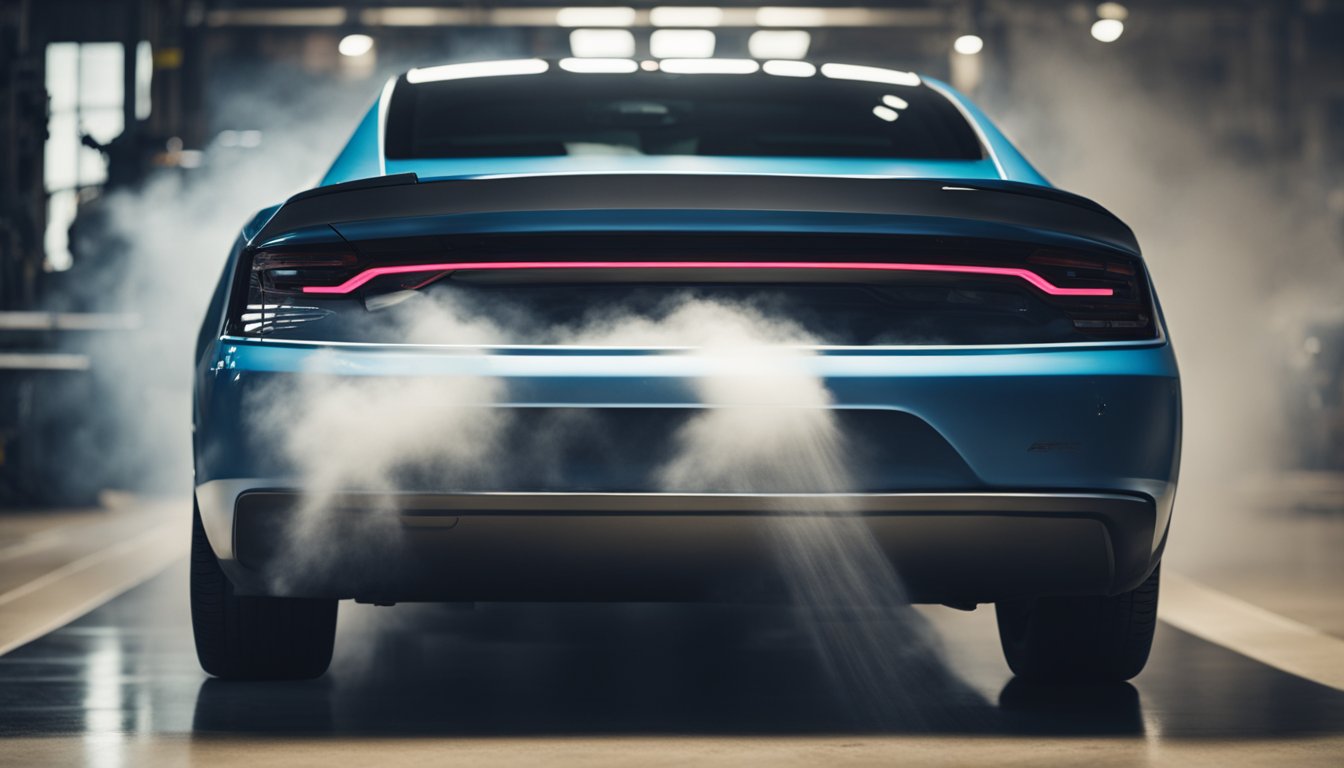
Electric air dusters offer remarkable versatility beyond just blowing away dust and debris. With some simple modifications, your air duster can transform into an effective automotive vacuum cleaner for comprehensive car interior maintenance.
How To Convert An Electric Air Duster Into A Vacuum Cleaner
Most electric air dusters can be converted to vacuum mode through a simple configuration change. Check if your model has a reverse airflow function or a dedicated vacuum port. If available, attach the appropriate nozzle adapter that came with your device.
For models without built-in vacuum functionality, specialized conversion kits are available.
These typically include a collection bag or canister, vacuum nozzle attachments, and connector pieces.
Installation generally follows these steps:
- Remove the standard blower nozzle
- Attach the vacuum adapter to the intake port
- Connect the collection bag or container
- Secure all connections to prevent air leakage
Test the suction power before beginning a full cleaning session. The vacuum should provide sufficient force to lift small debris and dust from car surfaces.
Best Practices For Vacuuming Car Interiors
Start with a decluttered car interior to maximize vacuum efficiency. Remove large items, floor mats, and seat covers before beginning the vacuuming process.
Work from top to bottom—headliner and dashboard first, then seats, and floor areas last. This prevents redistributing dirt to already-cleaned areas.
Use specialized attachments for different surfaces:
- Crevice tool for tight spaces and seams
- Brush attachment for fabric upholstery
- Narrow nozzle for air vents and console areas
Maintain a methodical approach, dividing the car interior into sections. Complete one area before moving to the next. Pay special attention to high-traffic surfaces like driver and passenger seats.
Common Vacuuming Applications:
Car Seats: Vacuum fabric seats with a brush attachment using overlapping strokes for thorough cleaning. For leather seats, use a soft brush attachment to prevent scratching while removing surface dust and debris.
Floor Areas: Target carpeted areas with slow, deliberate passes to extract embedded dirt. Focus extra attention on driver-side floor areas which typically accumulate more dirt and debris.
Storage Areas: Don’t overlook door pockets, cup holders, and center console compartments. These areas collect surprising amounts of debris and benefit from the precision of a handheld vacuum cleaner.
Dashboard and Vents: Use the narrowest attachment to clean air vents and dashboard crevices. The controlled suction of a vehicle vacuum prevents damage to sensitive electronic components while removing dust.
Part 4: Best Practices And Safety Tips For Car Cleaning
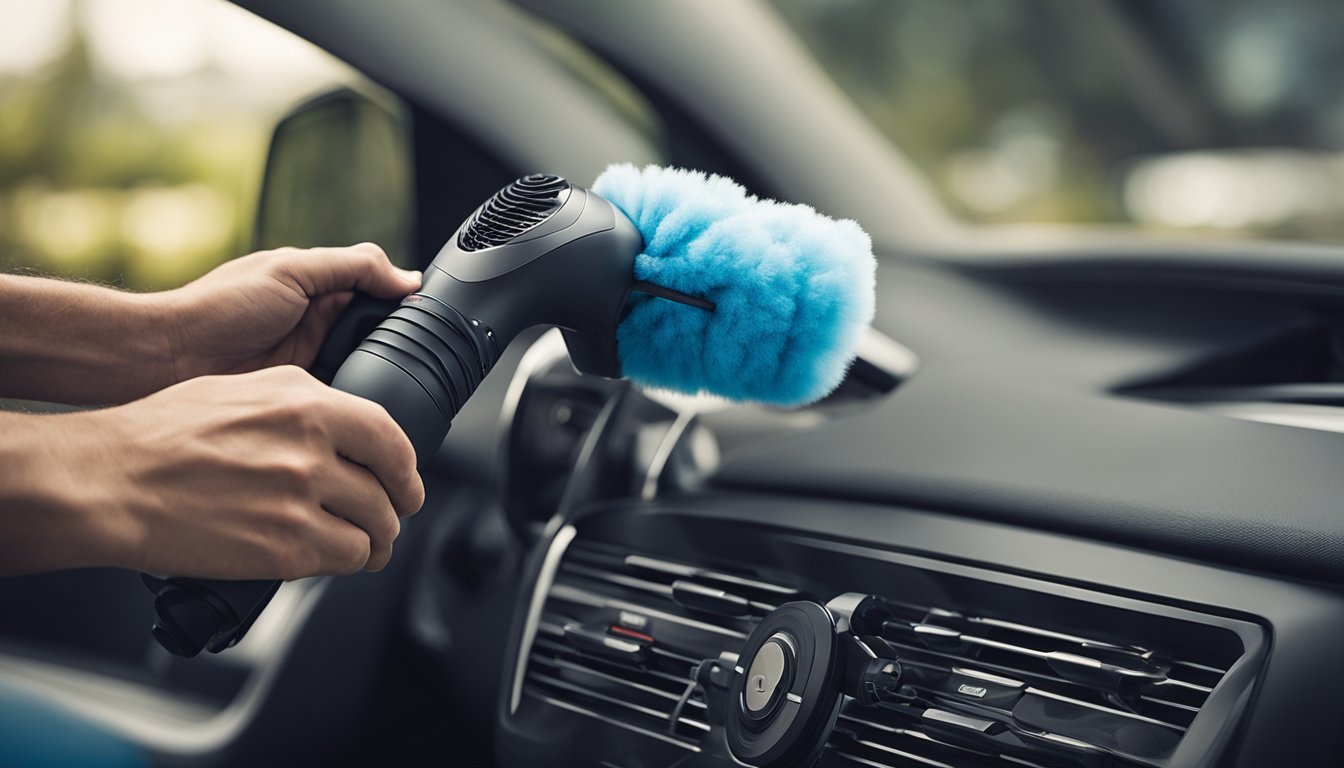
Using an electric air duster effectively requires proper technique and safety awareness. The following guidelines will help you maximize cleaning results while ensuring both your safety and longevity of your equipment.
Selecting The Right Nozzle Attachment
Electric air dusters typically come with multiple nozzle attachments designed for specific cleaning challenges.
The standard nozzle works well for general dusting of dashboard surfaces and center consoles.
For narrower areas like air vents and tight crevices, use the precision or concentrated nozzle attachment that delivers a focused stream of air.
These pinpoint attachments effectively dislodge dust from tiny spaces without damaging delicate components.
When cleaning sensitive electronics such as stereo systems or navigation screens, opt for the brush attachment that combines gentle bristles with air power.
This provides dual-action cleaning without risk of static damage.
For upholstery and carpets, select wider nozzle attachments that cover more surface area efficiently.
Many professional-grade dusters include specialized carpet attachments that agitate fibers while blowing air, lifting embedded dirt particles for more thorough cleaning.
Proper Technique For Effective Cleaning
Start cleaning from the top of your car interior and work downward. This gravity-assisted approach prevents recontamination of already cleaned areas as dust settles.
Hold the air duster at a 45-degree angle about 2-3 inches away from surfaces for optimal cleaning power.
Too close may damage sensitive materials, while too far reduces effectiveness.
Short bursts vs. continuous airflow: Use brief, controlled bursts on delicate areas like displays and electronics. For stubborn dirt in carpet or upholstery, continuous airflow works better.
Create a systematic pattern—left to right, front to back—to ensure complete coverage.
This methodical approach prevents missing spots, especially in less visible areas like under seats.
For car vacuuming efficiency, use the air duster first to loosen embedded particles, then follow with a vacuum cleaner.
This two-step process removes significantly more dirt than either method alone.
Maintenance Tips For Electric Air Dusters
Check and clean filters monthly to maintain optimal performance.
Most electric dusters have removable, washable filters that should be rinsed with water and thoroughly dried before reinstallation.
Inspect power cords for damage before each use.
Frayed or cracked cords present electrical hazards and should be professionally repaired or replaced immediately.
Store the duster in a cool, dry place away from direct sunlight or extreme temperatures.
Heat exposure can damage internal components and reduce the unit’s lifespan.
Empty the dust collection chamber after each use if your model features one.
This prevents clogs and maintains consistent airflow for future cleaning sessions.
Apply a drop of lubricating oil to moving parts every 3-6 months, particularly for models with adjustable speed settings or mechanical nozzle locks.
This simple maintenance extends operational life significantly.
Safety Precautions While Cleaning Cars
Always wear eye protection when using electric air dusters.
Dislodged particles can become airborne and cause eye irritation or injury.
Use in well-ventilated areas to avoid breathing in disturbed dust.
For extensive interior cleaning, consider wearing a dust mask, especially if allergies are a concern.
Never aim air dusters at people or pets, as the high-pressure air can cause injury.
Keep children at a safe distance during cleaning operations.
Turn off the engine completely before cleaning around electronic components.
This eliminates potential short circuits or electrical damage to sensitive car systems.
Temperature awareness: Avoid using electric dusters immediately after driving when engine components are hot.
Allow adequate cooling time to prevent potential melting of plastic nozzles or attachments when cleaning engine compartments.
Conclusion
Electric air dusters represent an essential tool for car enthusiasts and everyday drivers seeking efficient cleaning solutions.
Recap: Versatility And Efficiency Of Electric Air Dusters For Cars
Electric air dusters excel at removing dust and debris from hard-to-reach areas in vehicles.
Their consistent air pressure provides reliable cleaning power for vents, dashboards, center consoles, and electronic components without the risk of moisture damage.
Unlike canned air products, electric models maintain consistent pressure throughout operation, eliminating the frustration of diminishing output.
The rechargeable nature of these devices makes them cost-effective over time, with a single purchase replacing dozens of disposable cans.
Environmental benefits cannot be overlooked, as electric dusters eliminate the chemical propellants found in traditional compressed air products.
This reduction in waste and harmful substances aligns with growing eco-conscious consumer values.
Final Recommendations On Maintaining Car Cleanliness
Regular maintenance with an electric air duster should be incorporated into monthly car cleaning routines.
Users should focus on areas that accumulate the most dust: air vents, seat rails, and instrument panels.
For optimal results, pair the air duster with microfiber cloths to capture loosened particles rather than simply redistributing them. This combination approach ensures maximum cleaning efficiency.
When selecting an electric air duster, buyers should prioritize models offering variable pressure settings, ergonomic design, and battery life appropriate for their needs.
Premium features like LED lights may justify higher costs for serious detailers.
Storage of the duster in the vehicle—perhaps in the trunk or glove compartment—enables immediate cleaning when needed, preventing build-up that becomes harder to remove over time.
Frequently Asked Questions
Electric air dusters have become essential tools in the automotive care arsenal, offering practical solutions for detailing challenges while providing environmental and efficiency advantages over traditional methods.
What are the primary uses of electric air dusters in automotive detailing?
Electric air dusters excel at removing dust and debris from hard-to-reach areas of a vehicle’s interior.
They effectively clean air vents, dashboard crevices, and center console buttons without causing damage to delicate components.
These powerful tools also help clean sensitive electronic areas such as infotainment systems and instrument clusters where liquid cleaners might cause harm.
Professional detailers use them to prepare surfaces before applying protective coatings or treatments.
For exterior detailing, electric air dusters can blow water from panel gaps, emblems, and mirrors after washing, preventing water spots and streaking.
They’re particularly useful for cleaning wheel spokes, brake components, and engine bays without introducing moisture.
Which features should one consider when choosing an electric air duster for car cleaning?
Power output is crucial—look for units with adjustable pressure settings to handle both delicate interior surfaces and stubborn exterior debris.
Battery life matters significantly for cordless models, with premium options offering 30+ minutes of continuous operation.
Attachment variety enhances versatility, with precision nozzles for tight spaces and brush attachments for loosening stubborn dirt.
Ergonomic design and weight balance reduce hand fatigue during extended detailing sessions.
Filter systems in higher-end models prevent the unit from recirculating dust back into the vehicle’s cabin.
Consider models with LED lights for improved visibility when cleaning dark interior areas or engine components.
How do electric air dusters compare to traditional compressed air cans for vehicle maintenance?
Electric air dusters provide consistent air pressure throughout their operation, unlike canned air that weakens as the can depletes.
The reusable nature of electric dusters makes them more economical over time, eliminating the need to purchase disposable cans repeatedly.
With electric options, there’s no risk of expelling propellant chemicals or causing freezing damage to vehicle surfaces.
Professional-grade electric dusters deliver significantly higher airflow than canned alternatives, making them more effective for stubborn dirt removal.
Electric models offer greater control through variable speed settings, allowing for gentle cleaning of delicate areas and more forceful blasting for ground-in dirt.
They also eliminate the environmental waste associated with disposable aerosol cans.
What are the environmental benefits of using an electric air duster over aerosol options?
Electric air dusters eliminate the chemical propellants found in aerosol cans, which often contain hydrofluorocarbons that contribute to greenhouse gas emissions.
Their rechargeable nature significantly reduces waste from disposable cans that often end up in landfills.
Many modern electric dusters feature energy-efficient motors that minimize power consumption.
The absence of chemical propellants makes them safer for both the environment and the detailer’s respiratory health.
Electric options support sustainable detailing practices and align with increasing consumer demand for environmentally responsible car care products.
They represent a one-time purchase that replaces dozens or hundreds of disposable cans over their lifespan.
How can electric air dusters improve the efficiency of car cleaning?
Electric dusters speed up the detailing process by quickly removing dust and debris that would otherwise require tedious manual brushing or wiping.
Their powerful airflow can dislodge dirt from fabric upholstery and carpets, making subsequent vacuum cleaning more effective.
They eliminate the need for chemical cleaners in many situations, reducing both cleaning time and expense.
Professional detailers report significant time savings when incorporating electric dusters into their workflow, particularly for interior detailing tasks.
The precision of electric dusters allows for targeted cleaning of small components, improving overall detailing quality while reducing labor time.
Their effectiveness in drying water from crevices after washing prevents water spots and reduces the time spent hand-drying vehicles.
What safety precautions should be taken when utilizing electric air dusters in car cleaning?
Always wear protective eyewear to shield against airborne particles that may be dislodged during cleaning.
Consider using a dust mask when cleaning particularly dirty areas to prevent inhalation of fine particulates.
Keep electric dusters away from liquids and never use them on wet surfaces unless specifically designed for such use.
Maintain a safe distance when cleaning electronic components to prevent static electricity damage.
Ensure proper ventilation when using electric dusters in enclosed spaces like garages.
Follow manufacturer guidelines regarding operating temperatures and duty cycles to prevent overheating of the device during extended use.

